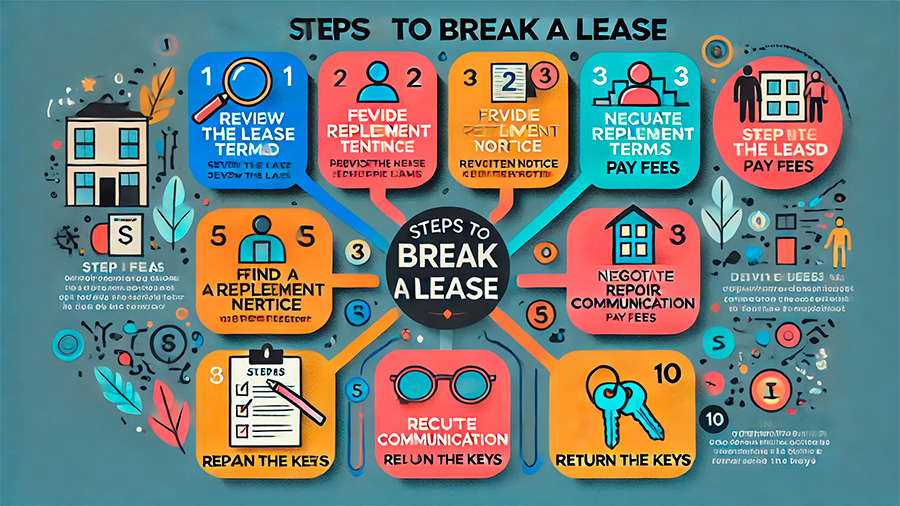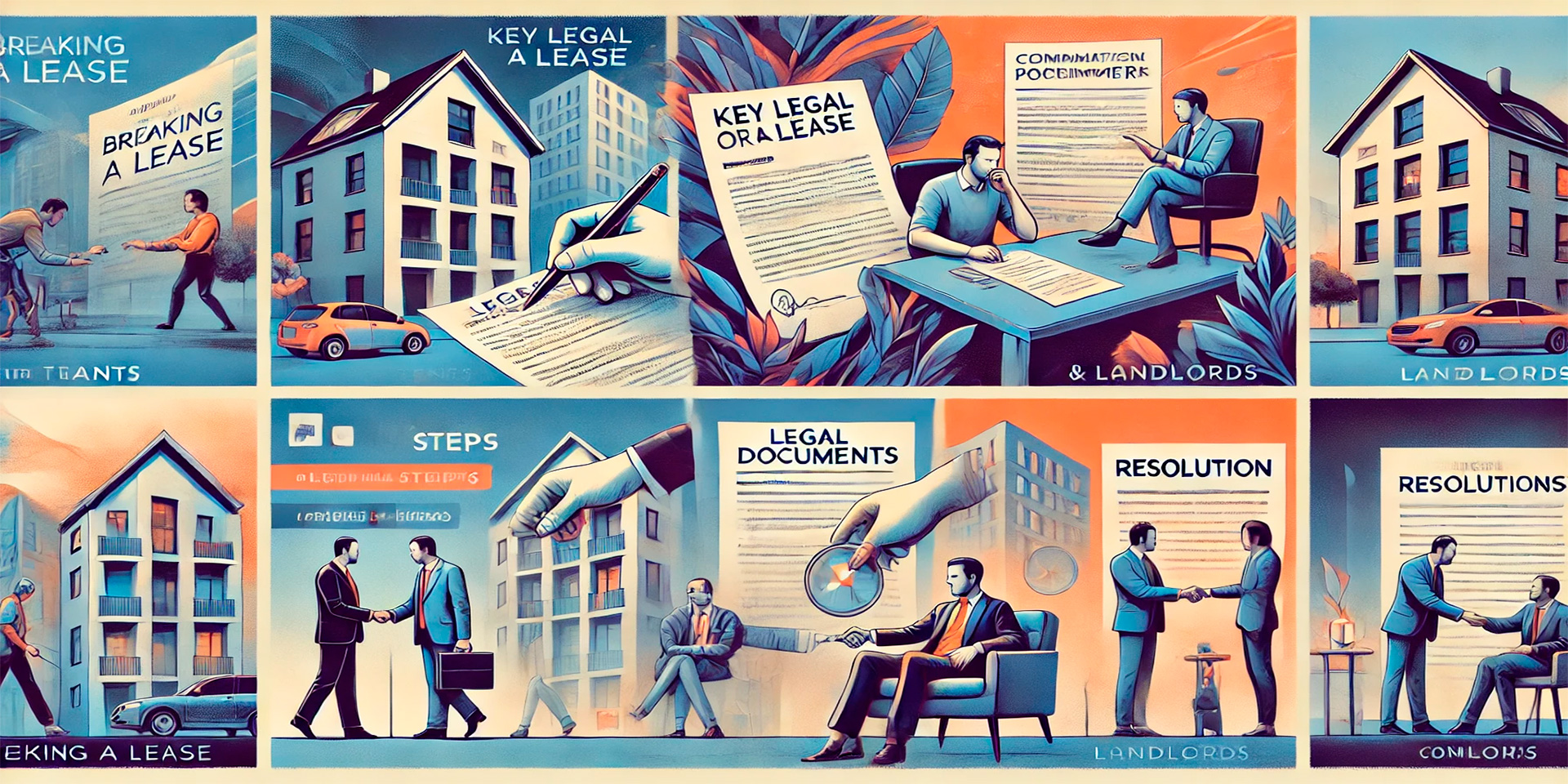Breaking a lease is not an uncommon situation, but it can have serious legal and financial implications for both tenants and landlords. Whether due to unforeseen life changes or dissatisfaction with the rental arrangement, tenants may find themselves needing to end their lease early. For landlords, an unexpected lease termination can disrupt cash flow and lead to a search for new tenants. Understanding the legal considerations and proper steps for breaking a lease can help both parties avoid costly mistakes and potential disputes.
This guide outlines the key legal aspects of breaking a lease, the steps tenants and landlords should follow, and common scenarios where lease termination may be permissible without penalties.
Understanding Lease Agreements
A lease agreement is a legally binding contract between a landlord and a tenant that outlines the terms and conditions of renting a property. These agreements typically cover the lease duration, rent payments, maintenance responsibilities, and rules for ending the lease. When a tenant signs a lease, they agree to abide by its terms for the full duration, often six months to a year or more. Breaking a lease, in legal terms, means ending the rental contract before its agreed-upon expiration date.
However, breaking a lease isn’t always straightforward. There can be financial consequences, including paying rent for the remaining months or forfeiting the security deposit. Tenants and landlords should be aware of their rights and obligations to minimize potential issues when ending a lease prematurely.
Reasons Tenants May Want to Break a Lease
Tenants may seek to break a lease for various reasons, some of which may be legally justified, while others may lead to penalties. Common reasons for breaking a lease include job relocation, health issues, family emergencies, dissatisfaction with the rental property, or safety concerns.
In some cases, tenants can break a lease without penalties if certain conditions are met. These include the landlord failing to maintain the property, violating privacy rights, or not addressing health and safety concerns. In other cases, tenants may face legal and financial consequences if they break the lease for reasons that are not protected by law.
Valid Reasons to Break a Lease Without Penalty
Certain legal protections allow tenants to break a lease without penalty. These include:
- Uninhabitable conditions: If the rental property becomes uninhabitable due to health and safety violations, such as mold, pest infestations, or structural damage, the tenant may be legally justified in breaking the lease.
- Landlord violations: If the landlord fails to make necessary repairs, violates the tenant’s privacy, or breaches the lease agreement in other ways, the tenant may have the right to terminate the lease.
- Military duty: Under the Servicemembers Civil Relief Act (SCRA), active-duty military personnel can break a lease if they receive orders for deployment or relocation.
- Domestic violence: In some states, victims of domestic violence may be allowed to break a lease without penalty if they need to move for their safety.
Tenants should review their local laws and consult their lease agreement to determine if their situation qualifies for breaking the lease without financial repercussions.

Steps Tenants Should Take to Break a Lease
When a tenant decides to break a lease, there are specific steps they should take to minimize potential legal consequences and maintain a good relationship with the landlord. Proper communication and a clear understanding of the lease terms can help prevent disputes.
1. Review the Lease Agreement
The first step in breaking a lease is to carefully review the lease agreement. Most leases include a section outlining the conditions for early termination, such as notice periods, potential fees, or the obligation to pay rent until a new tenant is found. Understanding these terms is crucial for avoiding unexpected costs and ensuring that you follow the legal process for terminating the lease.
2. Provide Written Notice
Tenants are typically required to give written notice of their intention to break the lease. The notice period may vary depending on the lease terms and local laws, but it usually ranges from 30 to 60 days. In the written notice, tenants should clearly state their reason for breaking the lease and the expected move-out date. Keeping a copy of the notice for personal records is recommended, as it serves as proof of communication.
3. Negotiate with the Landlord
In some cases, tenants may be able to negotiate an early termination with the landlord. If the tenant’s reason for breaking the lease is not covered by legal protections, they can try to reach an agreement with the landlord, such as paying a lease termination fee or covering rent until a new tenant is found. Open communication and flexibility can help both parties reach a mutually beneficial solution.
4. Find a Replacement Tenant
Depending on the lease terms and state laws, tenants may be responsible for finding a replacement tenant to take over the lease. This process, known as lease assignment or subletting, allows the tenant to transfer their obligations to someone else. In many cases, landlords are legally required to make a reasonable effort to re-rent the unit, but tenants can help by actively looking for potential renters.

Potential Consequences for Breaking a Lease
Breaking a lease without following the proper steps or without legal justification can lead to financial and legal consequences. Tenants may be required to pay rent for the remainder of the lease term or until the landlord finds a new tenant. In addition, they may lose their security deposit or face legal action from the landlord for breach of contract.
Financial Penalties
If a tenant breaks a lease without a valid reason, they may be responsible for paying rent until the unit is re-rented or the lease expires. Some leases include an early termination fee, which is typically equivalent to one or two months’ rent. This fee allows tenants to break the lease without being held responsible for the remaining months, but it must be explicitly stated in the lease agreement.
In addition, tenants may lose their security deposit if they break the lease prematurely. Landlords often use the security deposit to cover unpaid rent, damages, or cleaning costs when a tenant vacates the property early.
Damage to Credit Score
Breaking a lease without resolving any outstanding financial obligations can negatively impact a tenant’s credit score. If a landlord sends the unpaid balance to a collections agency or sues for breach of contract, the tenant’s credit score could suffer. This can make it harder to rent a new apartment or qualify for loans in the future.
Landlord Considerations When a Tenant Breaks a Lease
When a tenant breaks a lease, landlords must navigate the situation carefully to avoid legal issues and minimize financial loss. Landlords have the right to pursue compensation for unpaid rent, but they also have responsibilities under the law, including the duty to mitigate damages.
1. Re-Renting the Property
In most states, landlords are required to make reasonable efforts to re-rent the property when a tenant breaks the lease. This means actively marketing the unit and accepting qualified applicants. If the landlord successfully finds a new tenant, the original tenant may no longer be responsible for the rent. However, if the landlord cannot find a new tenant despite reasonable efforts, the original tenant may be liable for the remaining rent.
2. Collecting Damages
Landlords have the right to collect damages from tenants who break the lease, but the amount they can claim depends on the situation. Damages may include unpaid rent, costs for finding a new tenant, or repairs for damage to the property. However, landlords must follow state laws regarding security deposits and cannot charge tenants beyond what is reasonable and justified.
3. Avoiding Legal Disputes
To avoid legal disputes, landlords should communicate clearly with tenants who wish to break a lease. Providing clear expectations regarding notice periods, potential fees, and the re-renting process can help resolve the situation amicably. If a dispute arises, landlords should document all communications and follow the terms outlined in the lease agreement to protect their legal rights.
Conclusion: Legal Considerations for Breaking a Lease
Breaking a lease can be a complicated process with potential legal and financial consequences for both tenants and landlords. For tenants, understanding the lease terms, providing proper notice, and negotiating with the landlord can help minimize penalties. Landlords, on the other hand, must balance their right to collect unpaid rent with their responsibility to mitigate damages and follow state laws.
Whether you’re a tenant looking to end a lease early or a landlord dealing with a lease termination, clear communication and an understanding of legal obligations are key to resolving the situation fairly. By following the correct steps, both parties can avoid costly legal disputes and ensure a smoother transition during the lease termination process.

